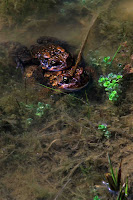 by Susan Post
by Susan PostThe first faint calls of frogs and toads are often heard during warm spells in late February or early March, but for many species, the warming days of spring bring on their true vocal talents. As both the soil and water gradually warm in spring, frogs and toads awaken from hibernation and assemble in or near shallow water where, as amphibians, they must lay their eggs. In most instances, sounds are produced only by the males, and are usually courtship calls to attract females into a breeding area, but can also be territorial calls to warn other males of rights to a particular spot. Each species has its own distinctive call and breeding period.
 Wood frogs are likely to be the first call heard as they are known to herald the retreat of winter. They sound like a soft, ducklike cackling in shallow ponds. The bird-like, whistling peep of the aptly-named spring peeper almost magically appears after the first warm rains of spring. Next to join in the music is the chorus frog, sounding much like a finger drawn across the teeth of a comb. Then come the omnipresent t
Wood frogs are likely to be the first call heard as they are known to herald the retreat of winter. They sound like a soft, ducklike cackling in shallow ponds. The bird-like, whistling peep of the aptly-named spring peeper almost magically appears after the first warm rains of spring. Next to join in the music is the chorus frog, sounding much like a finger drawn across the teeth of a comb. Then come the omnipresent t rills of the toads, and somewhat later, the cricket frog will add to the chorus, with mechanical clicks reminiscent of two pebbles striking together. The impressive, double, deep bass notes sung by extremely territorial bullfrogs from May to July have been likened to dueling tubas!
rills of the toads, and somewhat later, the cricket frog will add to the chorus, with mechanical clicks reminiscent of two pebbles striking together. The impressive, double, deep bass notes sung by extremely territorial bullfrogs from May to July have been likened to dueling tubas!
Calm, undisturbed waters with abundant insect life such as swampy, marshy areas, temporary ponds, small lakes, and quiet streams, are all good places to listen to and look for some of these more common toads and frogs. But, toads and frogs are very alert and will often stop calling and leap to the safety of deeper water if disturbed. Also, many species are experts at "throwing" their voices, which makes finding them even more difficult. Simply sitting quietly near one of these likely spots will most often result in actually locating a calling frog or toad. Better yet, for those fortunate enough to live near an active breeding site, the back porch may offer the best seat in the house for these nightly amphibian arias. Although it's unlikely they'll ever threaten the reputation of the Chicago Symphony, the repertoires of toads and frogs create a curious, somewhat captivating, night symphony all their own.
Video 1: Calls of Wood Frogs and Peepers; Video 2: Calls of Illinois Chorus Frogs



They seems like a soft, duck like cackling in shallow ponds.
ReplyDeleteSolar Lights Outdoor